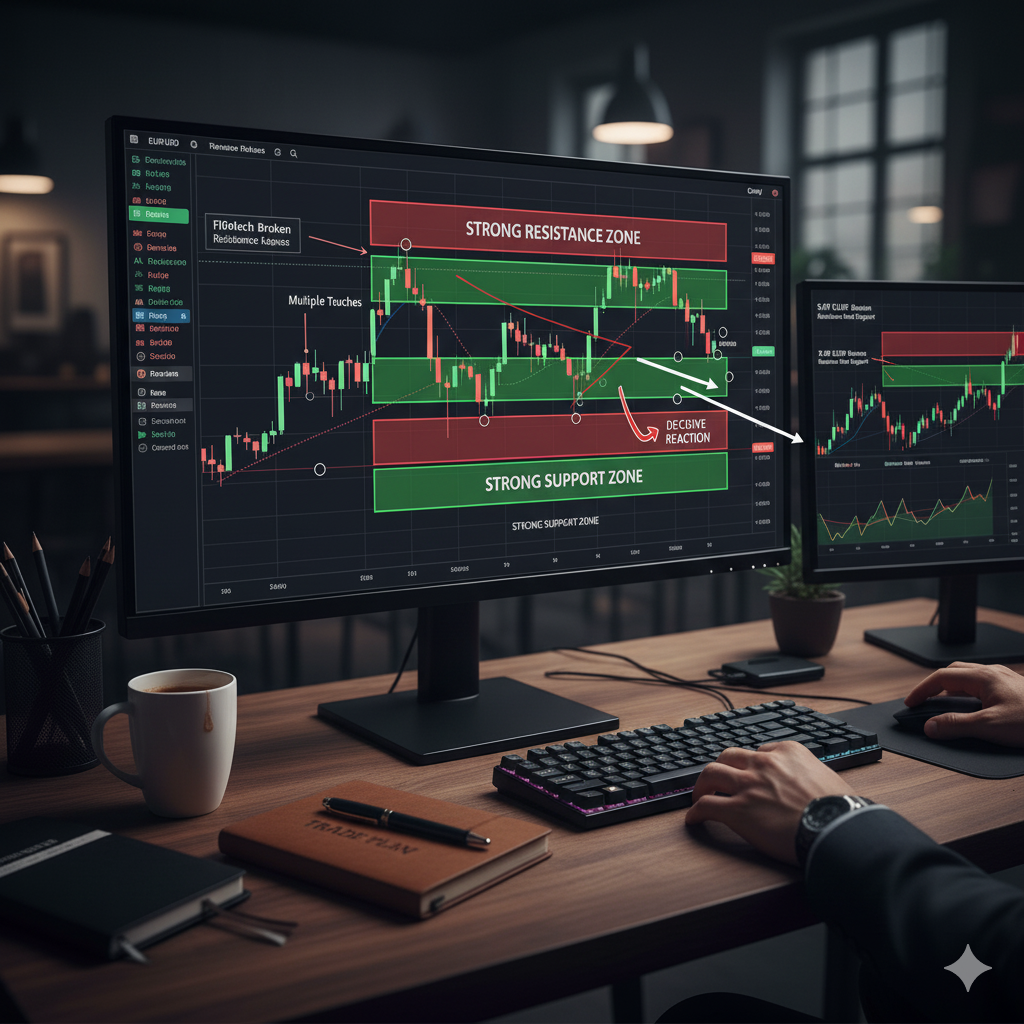In Forex trading, price action is like a story—filled with tension, turning points, and moments of reversal. The two main characters in this story are Support and Resistance, the invisible walls that guide the flow of price.
If you’ve ever wondered why a currency pair bounces repeatedly at certain price levels or struggles to break above others, you’re witnessing support and resistance in action. Mastering these concepts gives you a deeper understanding of market psychology—and helps you make smarter trading decisions.
In this post, we’ll explore:
- What Support and Resistance mean.
- How to draw static and dynamic levels.
- How psychological round numbers influence traders’ behavior.
- Examples that make it all click for beginners.

🧩 What Are Support and Resistance?
Support is a price level where demand is strong enough to stop price from falling further.
Resistance is a level where selling pressure prevents price from rising higher.
Think of them as floors and ceilings in a price chart. When price falls to a floor (support), buyers step in. When price rises to a ceiling (resistance), sellers take over.
Example
Let’s say the EUR/USD pair keeps falling to 1.0500 and bouncing back up. Traders begin to see this level as strong support. Conversely, if EUR/USD repeatedly fails to break above 1.0900, that area becomes known as resistance.
These zones often form because of market memory—traders remember past reactions and act accordingly when price returns to those areas.
📈 The Psychology Behind Support and Resistance
Support and resistance levels exist because of human behavior.
When price approaches a level where traders previously bought or sold heavily, they often repeat the same actions:
- Buyers look to buy again at past lows (support).
- Sellers look to sell again at past highs (resistance).
This repeated behavior reinforces those price levels and keeps the cycle going.
It’s not magic—it’s psychology in motion.
🧭 Drawing Static Support and Resistance Lines
Static levels are horizontal lines drawn across the chart at significant highs and lows. They remain fixed, no matter how price moves afterward.

How to Identify Them
- Look for swing highs and lows – these are turning points where price changed direction.
- Mark the zones where price reversed multiple times.
- Adjust slightly to create zones rather than thin lines.
Example
If GBP/USD has turned upward three times around 1.2200, you can draw a support line there.
If it reversed downward twice near 1.2600, that’s a resistance line.
Static S/R lines help traders spot entry and exit points, but they can also become zones of price interaction rather than exact levels.
Tip for Beginners
Use higher timeframes (like daily or 4-hour charts) when identifying major levels. They carry more weight and reliability than smaller timeframes like 5 minutes or 15 minutes.
🔄 Dynamic Support and Resistance (Moving Averages and Trendlines)
Unlike static levels, dynamic support and resistance move with price. They adjust to market conditions and are great for spotting trends.
1. Moving Averages as Dynamic S/R
Moving averages (like the 50-day or 200-day MA) often act as floating barriers.
- When price is above the moving average, it can act as support.
- When price is below it, the same line becomes resistance.
Example:
In a strong uptrend, EUR/USD might repeatedly bounce off the 50-day MA, showing buyers are defending that dynamic support level.
2. Trendlines
A trendline connects higher lows in an uptrend (support) or lower highs in a downtrend (resistance).
They visually guide you through the market’s direction and show where the price might pause or reverse.
Example:
In a bullish trend, connecting two or three higher lows with a diagonal line helps you predict potential bounce points.
Why Dynamic Levels Matter
Markets are not static—they evolve. Dynamic S/R tools help traders adapt to ongoing momentum and better time their trades.
💡 Static vs. Dynamic: Which Is Better?
Both types have unique benefits:
| Type | Description | Best Used For |
|---|---|---|
| Static S/R | Fixed horizontal levels based on past highs/lows | Spotting historical reversal zones |
| Dynamic S/R | Moving levels using trendlines or MAs | Following live trends and market rhythm |
Pro Tip: Combine both. For instance, if a moving average lines up with a historical support zone, the signal becomes stronger—a concept known as confluence.
💰 The Power of Psychological Round Numbers
Round numbers—like 1.0000, 1.1000, or 1.5000—hold special importance in Forex trading. These levels are called psychological support and resistance because human minds naturally gravitate toward them.
Why They Matter
- Easy to remember: Traders and institutions often place buy/sell orders at round numbers.
- Self-fulfilling prophecy: The more traders focus on a level like 1.2000, the stronger it becomes.
- Price hesitation: Market tends to pause or reverse near these levels.
Example:
If EUR/USD rises toward 1.1000, many traders might place take-profit or sell orders around that price. This selling pressure creates temporary resistance.
Tip
Watch how price reacts near round numbers—they often signal entry or exit opportunities before major moves.
⚙️ How to Trade Using Support and Resistance
Support and resistance are not just theory—they’re practical tools you can trade with. Here’s how:
1. Bounce Trading Strategy
Wait for price to reach a known S/R level, then trade in the opposite direction.
- Buy near support when price shows rejection (for example, a bullish candlestick).
- Sell near resistance when price shows hesitation or reversal (for example, a bearish engulfing candle).
Example:
EUR/USD touches 1.0500 support, forms a hammer candle, and starts to rise—this could be a buy signal.
2. Breakout Trading Strategy
Sometimes, price breaks through support or resistance and keeps going. These breakouts often signal strong new trends.
How to trade it:
- Wait for price to close beyond the level.
- Confirm with volume or momentum indicators.
- Enter in the direction of the breakout.
Example:
GBP/USD breaks above 1.2800 resistance and closes higher. A buy entry with a stop below 1.2780 might target 1.2900.
3. Role Reversal Concept
When a support level breaks, it often becomes new resistance—and vice versa.
Example:
If USD/JPY breaks below 150.00 (support), that same level may act as resistance when price retests it from below.
This concept reinforces how memory shapes market behavior.
🧮 Practical Example: Step-by-Step S/R Setup
Let’s walk through a simple process for beginners:
- Open EUR/USD on a 4-hour chart.
- Identify key swing lows around 1.0650 (support).
- Draw horizontal lines at those points.
- Identify swing highs near 1.0900 (resistance).
- Add a 50-day Moving Average to your chart for dynamic levels.
- Watch how price reacts near those static and dynamic barriers.
- Combine the observation with candlestick signals for better timing.
This method provides both structure and confirmation, giving you confidence in your analysis.
🧠 Common Mistakes Beginners Make
- Drawing too many lines: Stick to the most significant levels.
- Expecting precision: Price may react around a zone, not an exact number.
- Ignoring timeframes: Higher timeframe levels (like daily) override smaller ones.
- Forgetting fundamentals: News events can break even the strongest levels.
Stay flexible—support and resistance offer probabilities, not guarantees.
🚀 Bringing It All Together
Support and resistance are the foundation of technical analysis.
They reveal how traders think, where they act, and how the market breathes.
By learning to identify static levels, dynamic zones, and psychological price points, you’re not just drawing lines—you’re reading the market’s mind.
Key Takeaways
- Support = floor, Resistance = ceiling.
- Use both static and dynamic tools.
- Watch round numbers for hidden psychological power.
- Combine S/R with candlestick signals for stronger setups.
The more you practice, the more you’ll see these invisible walls guiding every price move—helping you trade with confidence and clarity.